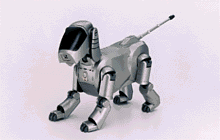 |
 |
 |
 |
 |
 |
|||||
 |
 |
 |
 |
|
MECHANICAL PETS: The Fun of Live Animals, Without the Hassle June 22, 1999  The surprisingly popular plastic pup. (Sony Corp.) Amid a growing craze for animal companions, robotic pets have appeared on the market and are quickly winning people's hearts. Equipped with the "brains" of a PC and an assortment of sensors, these robo-pets mimic live animals in their movements and expressions. Now in the offing are robots that can communicate with their owners and perform various tasks. Apartment restrictions on animals, plus the difficulty of caring for pets that are living longer, are helping fuel the popularity of nonliving "pets" and blurring the line between pets and robots. Emotional, Talking Robots The robotic dog can also "express" emotions. If you pat it on the head, an internal sensor registers the gesture as praise; the dog's tail wags, and its eyes turn green to show its pleasure. If you hit it, on the other hand, its eyes flash red in sadness or anger. The creature is also equipped with learning functions. For example, if you show it a red ball and strike it on the head, it will subsequently show aversion to the ball by shrinking away or shaking its head. But if you pat the robot affectionately when showing the ball, it will grow attached to it and follow it around, wagging its tail. The canine robot is being sold over the Internet in limited quantities (3,000 in Japan and 2,000 in the United States). Although rather expensive at 250,000 yen (2,500 dollars), all 3,000 units that were initially marketed in Japan sold out just 20 minutes after they went on sale, and the U.S. model has also sold out. Matsushita Electric Industrial Co., meanwhile, has developed stuffed-animal robots that look like cats and bears. These electronic pets can understand five phrases, like "Hello" and "What time is it?" When their owner calls them or touches them, they respond with pleasantries like "Good morning!" or "Have a nice day!" They are also equipped with the ability to make 15 gestures, like changing the expression in their eyes made of liquid crystal displays and moving their legs and ears. Matsushita plans to sell these robo-cats and bears for about 50,000 yen (400 dollars at 125 yen to the dollar). Although they will not be put on the market until 2001, the company said it has already received a flood of inquiries. Live Animals Require Commitment and Care It is not unusual for a cat or dog to live 15 years or longer--equivalent to a human life span of 80 years. Many of these aged pets suffer from ailments like atrophied legs and hips, missing teeth, and cataracts. Owners may have to help their pets eat, attend to their bodily functions, and so on. This care-giving role takes both an emotional and a physical toll, in addition to the considerable financial expense of veterinary treatment and pet-care products. Many owners also become despondent over the death of a beloved animal in a phenomenon called pet-loss syndrome. There are no small number of people who want pets but cannot have them because their landlords forbid it, the reasons being that pets dirty up the property or the neighborhood and disturb others with their barking or meowing. Many people secretly violate the pet prohibition, which has led to a growing number of conflicts between neighbors. For these reasons, some people have turned to small, silent pets like reptiles or tropical fish. A few years ago, electronic pocket-sized "pets" called Tamagotchi were all the rage. The more recent emergence of robotic pets is an extension of this trend.  Edited
by Japan Echo Inc. based on domestic Japanese news sources. Articles presented
here are offered for reference purposes and do not necessarily represent
the policy or views of the Japanese Government. Edited
by Japan Echo Inc. based on domestic Japanese news sources. Articles presented
here are offered for reference purposes and do not necessarily represent
the policy or views of the Japanese Government.
|

